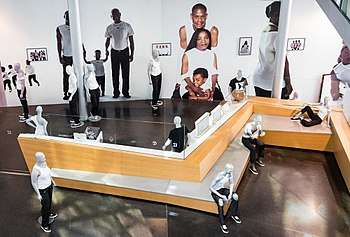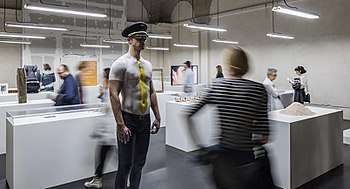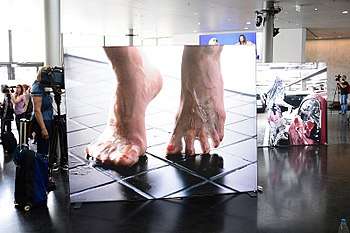9th Berlin Biennale for Contemporary Art

The 9th Berlin Biennale for Contemporary Art, held in 2016, was curated by the collaborative project DIS and titled The Present in Drag. The IXth Berlin Biennale proposed to explore the present moment which, according to the official press release “[...] is unknowable, unpredictable, and incomprehensible—forged by a persistent commitment to a set of fictions.”[1]
Projects and Artists
DIS chose to create a separate website for the IXth Berlin Biennale, in addition to the institutional website. Thus the internet is considered one of the venues within which the Biennale occurred and is now archived.[2] Babak Radboy (of art collective Shanzhai Biennial) was invited by DIS to implement the communications strategy in general. The other venues were the KW Institute for Contemporary Art, Akademie der Kunste, The European School of Management and Technology (ESMT), The Feuerle Collection, and a blue-star sightseeing boat.

Artists invited included Ryan Trecartin and Lizzie Fitch, South African collective CUSS Group, Cecile B. Evans, fashion brand TELFAR, Jon Rafman, Amalia Ulman, Wu Tsang, Anna Uddenberg, GCC, and others.
Anthem, the official soundtrack for the biennial, was released as a limited edition of vinyl singles released throughout the duration of the show, with collaborative tracks by artists and musicians, such as Isa Genzken and Total Freedom.[3]
Artist Trevor Paglen collaborated with hacker and computer security researcher Jacob Appelbaum to create Autonomy Cube, a “useable sculpture” that is a router for the anonymous internet software Tor. The room where the piece is installed becomes a secure, anonymous hotspot, with the hardware that enables internet freedom at its heart.
.jpg)
Persian Gulf based collective GCC filled a large room in an upper floor of the European School of Management and Technology with sand, a maroon track field, and the sculptures of a mother and son in contemporary attire from the Arab Gulf States. New Age aphorisms play over the speakers, and the mother’s pose indicates that she is practicing “quantum touch” on her child. A windswept scene of modern, globally hybridized beliefs, the installation expresses how capitalist and spiritual trends alike have been adopted in their highly traditional but swiftly modernizing home states.[4]
Anna Uddenberg’s figures, part-human, part-cargo, and at times, part architectural elements, were also included.

A Blue-Star tour boat was the venue for Korakrit Arunanondchai and Alex Gvojic’s collaborative work for the Biennale, and hosted Boat Rage, a series of events that spanned musical performances, literary readings, and fashion presentations along the Spree.[5]

Critical reception and Controversy
The IXth Berlin Biennale stirred some controversy among critics and audiences. James Farago, of the Guardian, wrote a scathing review, describing the art event as ‘an ultra-slick, ultra-sarcastic biennial, replete with ads, avatars, custom security guard uniforms, a manic social media presence disposed to hashtags like #BiennaleGlam, and a woman lip syncing to Trap Queen.’[6]
However, it is for these same reasons that the Biennale was equally celebrated.[7][8][9][10] In the September 2016 Issue of Artforum, British artist Hannah Black wrote that “…They [DIS] have been greeted, just like the modernist avant-gardes were in their time, with accusations of bad politics and even worse taste. Perhaps these critics haven’t noticed: The world is a ruin, but we go on living in it…”
References
- ↑ "The Present in Drag".
- ↑ Edmonson, Tess (June 1, 2016). "DIS Placed: Q&A with the Curator of the Berlin Biennale". Canadian Art.
- ↑ Perlson, Hili (13 October 2016). "Review of the 9th Berlin Biennale". Artnet News.
- ↑ McGarry, Kevin (15 December 2016). "All the Highlights of the 9th Berlin Biennale". Artnet News.
- ↑ Perchman, Alexandra (8 May 2017). "THE COMPLETE GUIDE TO THE BERLIN BIENNALE". Visionaire Blog.
- ↑ Farago, Jason (June 13, 2016). "Welcome to the LOLhouse: how Berlin's Biennale became a slick, sarcastic joke". The Guardian.
- ↑ "Drag Race". Artforum. June 12, 2016.
- ↑ Smith, William S. (September 1, 2016). "Biennials: Mixed Messages". Art in America.
- ↑ Malick, Courtney (July 2016). "9th Berline Biennale: The Present in Drag". Art Papers.
- ↑ Bock, Stefan (August 18, 2016). "The Present in Drag". der Freitag.